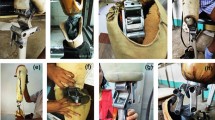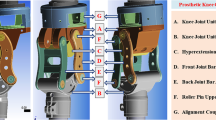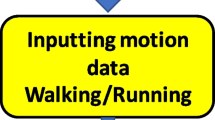Abstract
The activities of transfemoral amputees depend upon the prosthetic knee joint for rehabilitation, which must bear the required load. A patient-specific design of a passive polycentric four-bar knee joint is evaluated based on ISO-10328 and a maximum normal stress theory followed by weight compatibility and knee flexion–extension test during a gait cycle conducted with a trans-femoral amputee, where the maximum von Mises stress is found to be 260 MPa for test load conditions II as per ISO-based approach. However, it is observed to be 233 MPa in the case of a maximum normal stress theory approach. The developed knee joint has 12 different configurations, which are categorized into Groups A, B, and C configurations, representing a set of 4 configurations in each group based on changes in the length of vertical and horizontal links. The ISO-based approach prescribes a maximum load of 65 kg for all group configurations, whereas the maximum normal stress theory recommends to use for less than 100, 80, and 65 kg for Groups A, B, and C configurations, respectively. A prototype is developed using nylon-66, SS-304, and aluminium alloy-6061-T6 material, and it is fitted to a transfemoral amputee. The load-bearing and knee flexion–extension profile of the prosthetic knee joint is closely matched with that of the sound limb. The ISO-based analysis showed the increased factor of safety of the prosthetic knee joint in comparison with that of maximum normal stress theory, though the later is still found to be very safe to use.









Similar content being viewed by others
References
Radcliffe CW (1994) Four-bar linkage prosthetic knee mechanisms: kinematics, alignment and prescription criteria. Prosthet Orthot Int 18:159–173. https://doi.org/10.3109/03093649409164401
Chauhan SS, Khare AK (2022) Analysis of four-bar linkages suitable for above-knee prosthesis. Evergreen 9:737–744. https://doi.org/10.5109/4843107
Mohanty RK, Mohanty RC, Sabut S et al (2022) Conformity assessment with structural strength requirements of mechanical polycentric prosthetic knee used for amputee rehabilitation. Comput Methods Biomech Biomed Eng. https://doi.org/10.1080/10255842.2022.2088233
Marisami PM, Venkatachalam R (2023) Design and experimental validation of a high-performance polycentric prosthetic knee joint for transfemoral amputees in develo** countries. J Brazilian Soc Mech Sci Eng 45:146. https://doi.org/10.1007/s40430-023-04072-6
Amador BT, Muller-Karger CM, Casanova E et al (2013) Sturctural analysis during the design of polycentric prosthetic knee. 24th Congr Int Soc Biomech 24:10–12. https://doi.org/10.13140/RG.2.1.1079.3124
Kadhim FM, Chiad JS, Takhakh AM (2018) Design and manufacturing knee joint for smart transfemoral prosthetic. In: IOP conference series: materials science and engineering, vol 454. https://doi.org/10.1088/1757-899X/454/1/012078
Sugiyanto BP, Alhakim B, Setiana R et al (2017) Stress analysis of four-bar linkage transfemoral prosthetic in gait cycle. Int J Appl Eng Res 12:9333–9337
ISO 10328 (2006) Prosthetics–structural testing of lower-limb prostheses–requirements and test methods, 2006
Phanphet S, Dechjarern S, Jomjanyong S (2017) Above-knee prosthesis design based on fatigue life using finite element method and design of experiment. Med Eng Phys 43:86–91. https://doi.org/10.1016/j.medengphy.2017.01.001
Mangera T, Kienhofer F, Carlson KJ et al (2015) Optimal material selection for the construction of a paediatric prostehtic knee. Proc Inst Mech Eng Part L J Mater Des Appl. https://doi.org/10.1177/1464420715620228
Chauhan SLS, Bhaduri SC (2020) Structural analysis of a four-bar linkage mechanism of prosthetic knee joint using finite element method. Evergreen 7:209–215. https://doi.org/10.5109/4055220
Gopinath G, Krishnan H, Bandaru K et al (2019) A biomimetic design of an artificial knee for lower limb prosthesis. ACM Int Conf Proc Ser. https://doi.org/10.1145/3352593.3352661
Kamel SH, Hamzah MN, Atiyah QA et al (2021) Modeling and analysis of a novel smart knee joint prosthesis for transfemoral amputation. IOP Conf Ser Mater Sci Eng 1094:012109. https://doi.org/10.1088/1757-899x/1094/1/012109
Sundararaj S, Subramaniyan GV (2020) Structural design and economic analysis of prosthetic leg for below and above knee amputation. Mater Today Proc 37:3450–3460. https://doi.org/10.1016/j.matpr.2020.09.331
Vaibhav J, Kanagaraj S (2023) Passive polycentric knee joint. Application no-202031017295, Patent Grant No.- 490011. Itellectual Property India; 2023
Mohanty RK, Mohanty RC, Sabut SK (2022) Finite element analysis and experimental validation of polycentric prosthetic knee. Mater Today Proc 63:207–214. https://doi.org/10.1016/j.matpr.2022.02.509
Blumentritt S, Schmalz T, Jarasch R et al (1999) Effects of sagittal plane prosthetic alignment on standing trans-tibial amputee knee loads. Prosthet Orthot Int 23:231–238. https://doi.org/10.3109/03093649909071639
Al-Maliky FT, Chiad JS (2022) Study and analysis the flexion moment in active and passive knee prosthesis using back propagation neural network predictive. J Braz Soc Mech Sci Eng 44:1–7. https://doi.org/10.1007/s40430-022-03850-y
Kaufman KR, Levine JA, Brey RH et al (2007) Gait and balance of transfemoral amputees using passive mechanical and microprocessor-controlled prosthetic knees. Gait Posture 26:489–493. https://doi.org/10.1016/j.gaitpost.2007.07.011
Kaufman KR, Frittoli S, Frigo CA (2013) Gait asymmetry of transfemoral amputees using mechanical and microprocessor-controlled prosthetic knees. Clin Biomech 27:460–465. https://doi.org/10.1016/j.clinbiomech.2011.11.011
Funding
This work is financially supported by the Ministry of Human Resources and Development, India (IMPRINT project no- IMP/2018/000395).
Author information
Authors and Affiliations
Corresponding author
Ethics declarations
Conflict of interest
The authors declare that there is no conflict of interest.
Additional information
Technical Editor: Rogério Sales Gonçalves.
Publisher's Note
Springer Nature remains neutral with regard to jurisdictional claims in published maps and institutional affiliations.
Supplementary Information
Below is the link to the electronic supplementary material.
Rights and permissions
Springer Nature or its licensor (e.g. a society or other partner) holds exclusive rights to this article under a publishing agreement with the author(s) or other rightsholder(s); author self-archiving of the accepted manuscript version of this article is solely governed by the terms of such publishing agreement and applicable law.
About this article
Cite this article
Jaiswal, V., Kanagaraj, S. Structural testing of a passive polycentric knee joint with advanced functionalities designed and developed for patient-specific fitting. J Braz. Soc. Mech. Sci. Eng. 46, 254 (2024). https://doi.org/10.1007/s40430-024-04837-7
Received:
Accepted:
Published:
DOI: https://doi.org/10.1007/s40430-024-04837-7




